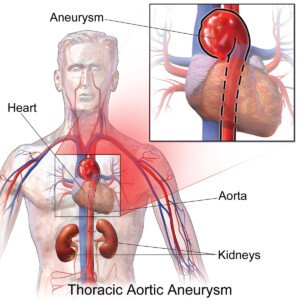An aortic aneurysm is more likely to occur in someone who was born with a bicuspid aortic valve (BAV).
“The aorta is the large artery carrying oxygenated blood away from the heart,” explains Dr. David Beatty, MD, a retired general practitioner with 30+ years of experience and an instructor of general medicine for 20+ years.
Dr. Beatty continues, “It climbs upwards out of the left ventricle (the ascending aorta) into the aortic arch where it curves downwards into the descending aorta.”
The aorta is the body’s biggest blood vessel.
“Arteries supplying blood to the heart muscle, brain, arms, kidneys and bowel branch off at various levels,” adds Dr. Beatty.
****
An investigation looked at the frequency of aortic aneurysm (and dissection) in people with BAV.
The data that was analyzed was of patients diagnosed with bicuspid valve, spanning 1980 to 1999; they were residents of Olmsted County, Minn.
Also analyzed was data involving people with aortic disease whose BAV had gone undiagnosed.
The last year of follow-up was 2008-2009. Included were 416 people with bicuspid valve; average follow-up was 16 years.
Risk of aortic aneurysm development in people with bicuspid valve: 26 percent over a 25-year period.
What does this translate to when compared to the general population? An 86 times greater risk of developing an aortic aneurysm.
What about risk of dissection in those with bicuspid valve? After all, an aortic aneurysm is a precursor to a dissection (size of aneurysm is directly proportional to risk of dissection).
People with bicuspid valve had an 8.4 times higher risk of dissection than people in the region’s general population.
This number may seem high, but the study authors state that the absolute risk of dissection still remains low in people with bicuspid valve.
Say the study authors: “The low aortic dissection incidence and lack of association with a detectable reduction in survival is reassuring.” The full report is in the Sept. 14, 2011 JAMA.
What else did this study unveil? Incidence of dissection was greater in people over age 50, and not surprisingly, higher in patients who had a baseline aortic aneurysm.
Percentage of people with BAV: 1-2 percent
Symptoms of bicuspid aortic valve: Not all patients have symptoms, and in some cases, one may live a normal life span minus BAV problems.
How BAV is usually discovered: Incidentally during a routine physical, or an imaging test for an unrelated condition.
Symptoms are a heart murmur (not always present) and rapid changes in blood pressure during stress or activity.
Complications: aortic aneurysm as well as dissection; leakage of blood back into the heart; narrowing of the valve, which can lead to a thickened, inefficient heart; mitral valve leakage.
If you’ve been diagnosed with a bicuspid valve, it’s very important to have it monitored on a regular basis for the possible development of an aortic aneurysm.


 Dr. Beatty has worked in primary medicine, surgery, accident and emergency, OBGYN, pediatrics and chronic disease management. He is the Doctor of Medicine for
Dr. Beatty has worked in primary medicine, surgery, accident and emergency, OBGYN, pediatrics and chronic disease management. He is the Doctor of Medicine for 







































